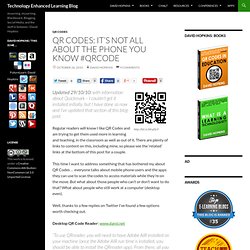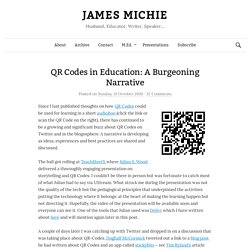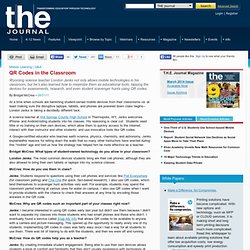

15 Creative QR Codes [PICS] QR Codes: In the Classroom. QR Codes: It’s not all about the phone you know #QRCode. Updated 29/10/10: with information about Quickmark – I couldn’t get it installed initially, but I have done so now and I’ve updated that section of this blog post.

Regular readers will know I like QR Codes and am trying to get them used more in learning and teaching, in the classroom as well as out of it. There are plenty of links to content on this, including mine, so please see the ‘related’ links at the bottom of this post for a couple. This time I want to address something that has bothered my about QR Codes … everyone talks about mobile phone users and the apps they can use to scan the codes to access materials while they’re on the move. But what about those people who can’t or don’t want to do that? What about people who still work at a computer (desktop even). Well, thanks to a few replies on Twitter I’ve found a few options worth checking out. Desktop QR Code Reader: www.dansl.net QuickMark Mobile Barcode (for PC): www.quickmark.com.tw bcWebCam: www.bcwebcam.de. 7 Things You Should Know About QR Codes.
QR codes are two-dimensional bar codes that can contain any alphanumeric text and that often feature URLs that direct users to sites where they can learn about an object or place (a practice known as “mobile tagging”).

Decoding software on tools such as camera phones interprets the codes, which are increasingly found in places such as product labels, billboards, and buildings, inviting passers-by to pull out their mobile phones and uncover the encoded information. QR codes link the physical world with the virtual by providing on-the-spot access to descriptive language and online resources for objects and locations.
In this way, the codes support experiential learning, bringing scholarship out of the classroom and into physical experience. QR code. QR code for the URL of the English Wikipedia Mobile main page, " QR code (abbreviated from Quick Response Code) is the trademark for a type of matrix barcode (or two-dimensional barcode) first designed for the automotive industry in Japan.

A barcode is a machine-readable optical label that contains information about the item to which it is attached. A QR code uses four standardized encoding modes (numeric, alphanumeric, byte / binary, and kanji) to efficiently store data; extensions may also be used.[1] The QR Code system became popular outside the automotive industry due to its fast readability and greater storage capacity compared to standard UPC barcodes. Applications include product tracking, item identification, time tracking, document management, and general marketing.[2] History[edit] QR Codes in Education: A Burgeoning Narrative. Since I last published thoughts on how QR Codes could be used for learning in a short audioBoo (click the link or scan the QR Code on the right), there has continued to be a growing and significant buzz about QR Codes on Twitter and in the blogosphere.

A narrative is developing as ideas, experiences and best practices are shared and discussed. The ball got rolling at TeachMeetX where Julian S. Wood delivered a thoroughly engaging presentation on storytelling and QR Codes. I couldn’t be there in person but was fortunate to catch most of what Julian had to say via UStream. What struck me during the presentation was not the quality of the tech but the pedagogical principles that underpinned the activities putting the technology where it belongs: at the heart of making the learning happen but not directing it. Showcasing Student Work with QR Codes. We believe that one of the key elements of inquiry based learning is designing student work with an authentic and purposeful audience in mind.

It's a key piece of the inquiry rubric that we use to guide our understanding of effective inquiry-based learning. We are continually trying to find places where student work can live beyond just the teacher's desk, including submitting work to film festivals, posting student videos online, providing opportunities for students to share their ideas with Faculty of Education professors, and creating online museums of student work. However, one of the simplest, easiest and most effective places to showcase student work is within our own school building. Like most schools, we believe the walls of our school should be covered with examples of student projects, artwork, ideas and initiatives.
QR Codes in the Classroom. Mobile Learning | Q&A QR Codes in the Classroom Wyoming science teacher London Jenks not only allows mobile technologies in his classroom, but he's also learned how to maximize them as educational tools, tapping the devices for assessments, research, and even student scavenger hunts using QR codes.

By Bridget McCrea08/31/11 At a time when schools are banishing student-owned mobile devices from their classrooms--or, at least making sure the disruptive laptops, tablets, and phones are powered down class begins--London Jenks is taking a decidedly different tack. A science teacher at Hot Springs County High School in Thermopolis, WY, Jenks welcomes iPhone- and Android-toting students into his classes.